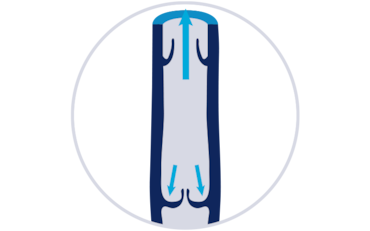Edema is the medical term for swelling caused by the accumulation of fluid in your body’s tissues. An edema is defined as chronic when it persists for more than three months. Several diseases can cause edema. However, this page will focus on edema caused by chronic venous disease. This is defined as stage 3 according to an internationally accepted standard that describes the manifestations of chronic venous disease (CEAP classification system). It usually affects the feet, ankle and legs.

What is edema?
What causes edema in the legs?
Edema is the first stage of chronic venous insufficiency (CVI). The valves in the blood vessels of the legs don’t work properly, allowing the pooling of blood in your legs. The higher pressure in the venous system causes an accumulation of fluid in your body’s tissue. The edema usually appears around the ankle and feet first and may ascend to the lower legs as well.
Another common type of edema is caused by an impaired lymphatic system. You can find more information about lymphedema here. Other diseases such as kidney disease, liver disease or congestive heart disease can also cause edema. However, the underlying reason is different to edema caused by CVI.

Valves working

Valves nonworking
Symptoms of edema
The accumulation of fluid makes the skin appear stretched and shiny. Applying pressure to your skin, e.g., with your thumb, will leave an indentation. This is also called “pitting edema”. The edema is typically worse after long periods standing or sitting and, in general, at the end of the day. Edema can cause a feeling of heaviness, aching, or discomfort. Advanced stages of CVI also show skin changes or can result in non-healing wounds, called venous leg ulcers.

How compression stockings can improve edema
Although there is no cure for weak veins and vein valves, wearing compression stockings can significantly improve edema caused by CVI. Compression stockings exert pressure on the tissue from the outside. Combining compression stockings and movement is especially effective. Activating the muscle pump compresses the veins between your muscles. This improves the venous return to the heart and thus improves symptoms such as pain, swelling and feelings of heaviness, aching or discomfort.
You can read more about how you reduce the risk for edema or CVI in general here.
